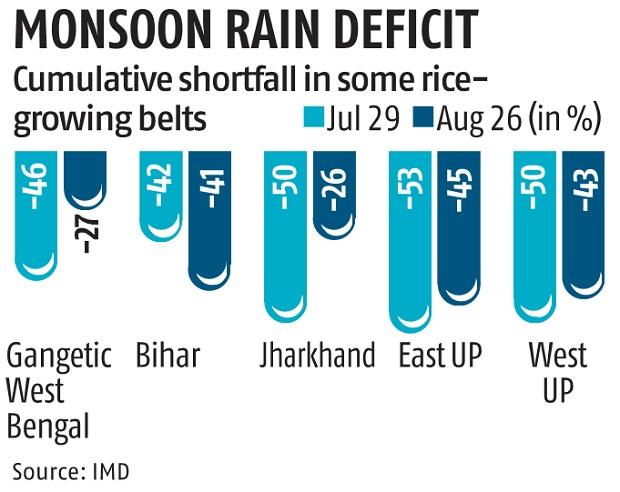The shortfall in the area under paddy cultivation for the week ended August 26 over the same period last year has narrowed to 5.99 per cent from 8.25 per cent in the previous week due to a pick-up in rain in West Bengal and Jharkhand.
This could ease some concern about a big drop in final output. However, a final analysis on output will be possible only when the harvest starts because much of the sowing in eastern India is happening after the ideal planting time, market participants said.
According to the latest data from the Ministry of Agriculture, during the week ended August 26, paddy was sown in around 36.75 million hectares as against 39.09 million hectares during the same period last year.
Till last week, paddy acreage across the country was 34.37 million hectares. Up to July 29, sowing was completed in just around 58.31 per cent of the normal area. This had risen to 92.5 per cent by August 26.
“Normal area” is the average covered in the last five years — 39.70 million hectares.

The narrowing of the deficit could have an impact on prices, which have risen by 5.5-12 per cent between July 1 and August 15 for some common varieties in select markets of the country. It could also influence the decisions of a meeting — scheduled for next week — of a high-powered panel of officials of the Central and state governments.
ALSO READ: Lower paddy acreage: How will it affect India and the world?
The meeting will take stock of the progress in sowing and price situation in order to finalise the procurement strategy for the next crop season, which will start on October 1, 2022. A strong pickup in acreage might also have an impact on any move to impose export restrictions.

India, the world’s second-largest producer and top exporter of rice, commands a 40 per cent share in the global rice trade. The country exported 21.2 million tonnes in 2021-22. Of that 3.94 million tonnes was basmati.
A Reuters report though said the government might consider imposing some restrictions on export of 100 per cent broken rice, which is less than 20 per cent of the country’s total annual rice export.
Meanwhile, the data showed that the kharif coverage of all crops also went up during the week ended August 26 and around 104.51 million hectares has been brought under cultivation — just 1.58 per cent less than in the same period last year.
In Gangetic West Bengal, the data sourced from the India Meteorological Department (IMD) shows that the cumulative monsoon deficit between June 1 and August 26 has narrowed to 27 per cent from a high of 46 per cent between June 1 and July 29.
Similarly, too in Jharkhand the deficit narrowed from 50 per cent on July 29 to 26 per cent on August 26. But, at the same, the deficit in other major paddy-growing areas such as Bihar and Uttar Pradesh hasn’t reduced much in the past one month.
The latest data shows till August 26, the major states that showed a deficit in paddy sowing over last year are Jharkhand (-1.05 million hectares), West Bengal (-0.46 million hectares), Chhattisgarh (-0.34 million hectares), Uttar Pradesh (-0.26 million hectares), Bihar (-0.24 million hectares), and Odisha (-0.22 million hectares).
“Rainfall levels remain broadly normal, with no material shift in the regional distribution. Still, a potential shortfall in paddy crop sowing and output may create concern, especially for countries importing rice from India,” said Rahul Bajoria, managing director and chief India economist at Barclays in a note.
The saving grace is that unlike wheat, rice stocks in the central pool are much higher than required. As on July 1, 2022, rice stocks in the Central pool are almost 134 per cent more than the buffer and strategic requirement.
 Dear Reader,
Dear Reader,
Business Standard has always strived hard to provide up-to-date information and commentary on developments that are of interest to you and have wider political and economic implications for the country and the world. Your encouragement and constant feedback on how to improve our offering have only made our resolve and commitment to these ideals stronger. Even during these difficult times arising out of Covid-19, we continue to remain committed to keeping you informed and updated with credible news, authoritative views and incisive commentary on topical issues of relevance.
We, however, have a request.
As we battle the economic impact of the pandemic, we need your support even more, so that we can continue to offer you more quality content. Our subscription model has seen an encouraging response from many of you, who have subscribed to our online content. More subscription to our online content can only help us achieve the goals of offering you even better and more relevant content. We believe in free, fair and credible journalism. Your support through more subscriptions can help us practise the journalism to which we are committed.
Support quality journalism and subscribe to Business Standard.
Digital Editor
Stay connected with us on social media platform for instant update click here to join our Twitter, & Facebook
We are now on Telegram. Click here to join our channel (@TechiUpdate) and stay updated with the latest Technology headlines.
For all the latest Business News Click Here
For the latest news and updates, follow us on Google News.
